By Christina Ameln, CSR | Sustainability Advisor –
It all started in the 1960s when grandmother Friedel Friedrich opened a room in her home in Frankfurt Oder in East Germany to a Vietnamese exchange student. [1] Energising discussions between her son Axel and this Vietnamese boarder stimulated the wish to explore this faraway place. Axel eventually travelled to Hanoi in the 1980s to study and married a young Vietnamese Tran Thi Minh Hoa.
“I have heard these stories my whole life and they made me aware of how my father always wanted to contribute to change and lift connections – first as a student and then as a translator. My mother, having grown up in circumstances different from me and my siblings, always insisted on how privileged we were, with a roof over our heads, food on our table, running water and electricity. Through them, and their joint wish to impart knowledge, links and impact, I knew that I would be working towards a positive change in one form or another”, recounts Felicitas Huong Friedrich, CSR and Education Manager of Schneider Electric Vietnam.
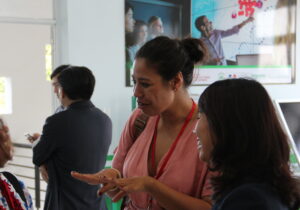
Felicitas on CSR and Sustainability in Vietnam and connecting energy.
While the aim was clear, she admits, “the journey was not always linear”.
Growing up in a small East German village where she stood as different, followed by travels and work in different parts of the world – including Vietnam – it was only when she decided to settle in Vietnam that she came to terms with the polarity of her dual nationalities. “Only then did I fully understand the positives of being from two places and the power of combining work with Schneider Electric in Vietnam and ‘doing good’ through CSR with the company. The vibrancy of Vietnam certainly contributed to my staying”.
The Energy Paradox
Despite the convergence on a personal level, the polarity continues in Felicitas work as she tries to bridge the schisms in today’s access to energy. “The world is changing and trends like urbanization, digitization and industrialisation increase the energy demand. As we run out of fossil fuels, we have to find other ways to manage energy more intelligently and efficiently. On the other hand, we must also acknowledge that today over 1 billion people worldwide have little or no access to electricity”.
Her words are a good reminder. I don’t often think about it. I have always had access to electricity. My two children live in Vietnam and they switch on the light as soon as early evening descends. With the light, they have countless opportunities that contribute to their growth, from reading to doing homework to playing a game together.
What a privilege.
And this is the privilege that Felicitas’ mother shared with her so early on in life and that Felicitas takes with her to her job every day. Felicitas and Schneider Electric want that privilege for everyone.
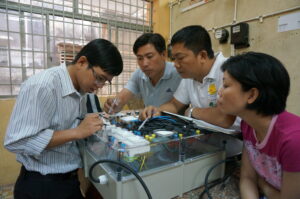
Schneider Electric’s ‘Life is On’
This 180-year old French multinational company develops connected technologies and solutions to manage and process energy in ways that are safe, reliable, efficient and sustainable. To be clear, they do not provide solutions to generate energy but cover the distribution line from point where energy is generated to the end consumer. Life is On is how the company works: from the simplest of switches to the most complex operational systems; its technology, software and services improve the way its customers manage and automate their operations. Felicitas felt from the first week of onboarding that this company is committed to living its mission: “Our connected technologies reshape industries, transform cities and enrich lives”.
Teaching How to Fish
The company goes one step further. It believes that access to energy and digital technology is a basic human right. To address this and the ‘energy paradox’, Schneider Electric developed in 2009 the Access to Energy program (A2E). A2E aims to ensure safe and reliable access to energy in emerging economies. Schneider Electric strongly believes that access to energy is a gateway to education, increased productivity of entrepreneurs and farmers, improvements in health and in quality of life and that they have a role to play in creating a movement to low-carbon energies. The program works through three pillars: Offers and Business Models by developing products and solutions for rural electrification capabilities by installing solar microgrids or solar lighting in remote communities; Impact Investment in Energy Start-ups for those with innovative energy access solutions; and Training and Entrepreneurship by providing job training in the electrical energy sector and support those that wish to become entrepreneurs.
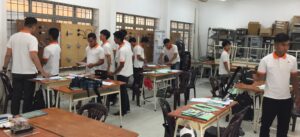
Schneider Electric’s sustainable work on – Access to Energy
As a result of this worldwide initiative and under their skills training pillar, 196,162 disadvantaged people have been trained for energy-related jobs. Many live in remote areas; do not have access to education; and are financially insecure especially minority groups and girls. They see many students become electricians and this means jobs and a more secure income for themselves and their families. In Vietnam, 5,000 people have been trained since 2015. The goal is to train 1 million people worldwide by 2025.
“The pressure is on. In my role to impact and educate, I am part of the journey to deliver on this goal. That is what makes it so exciting and significant” says Felicitas.
Schneider Electric now faces an important and increasingly relevant question: how is a global initiative transformed into a local one? Felicitas believes that the success in uptake of A2E is because “the program does not follow a single set of rules. A2E adapts to the needs of the countries in which it is implemented. In plain language: if the initiative does not apply to a given country context, we don’t launch it”.
Sequentially, local initiatives impact the global. As Felicitas points out, “As our training programs adopt international standards, we deliver highly qualified and competent electricians. As a result, Vietnam increases its global competitiveness. It becomes a chain reaction that demonstrates an age-old truth: Give a poor man a fish and he eats for a day. Teach him to fish and he gains an occupation that will feed him for a lifetime”.
Schneider Electric has supported 14 local vocational training centers through three NGO partners: ESF, ASSIST and IECD.
The Lead Wire
“I believe it is important to follow through, have a holistic view and ensure sustainability is part of what we do always and everywhere”. Felicitas makes this statement to describe how sustainability is the “lead wire” that runs throughout the organization from embedding the Sustainable Development Goals (SDGs), to ensuring it tracks and reports on its sustainability work and sets pointed targets, to working with partners. This is also what the company brought to the table at COP21 in 2015 when it unveiled its 10 sustainability commitments to be carbon neutral by 2030. The company committed to a new timeline at the Climate Week NYC 2019 and moved it up five years. It is expected to deliver this undertaking in 2025.
A company that focuses on connecting energy cannot be passive.
Through its core business, Schneider is set to invest 10 billion euros in innovation by the end of 2025 to support the transition to a more electric, digital, decarbonized and decentralized energy management. In being part of a circular economy, it has been deploying the Schneider ecoDesign Way™, which allows placement onthe market of products that offer greater maintainability, reparability, capacity for retrofitting and reprocessing at the end of the life cycle with the aim of having zero waste at their factories
At local level, Felicitas highlights that, “Here in Vietnam, we want to support economic development. We understand that there will be a higher demand for efficient energy management and we are committed to provide solutions to improve safety, reliability, efficiency, sustainability and connectivity for our customers”. In 2017, Schneider Electric’s factory in Saigon Hi-Tech Park was one of five LEED (Leadership in Energy and Environmental Development) Platinum projects. This illustrates a company that brings sustainability with it wherever it goes.
Light it Up
In the midst of its annual initiative known as ‘Light it Up’, which brings Schneider’s Electric solar Mobiya lamp to off grid communities together with partners including NGO GreendID. Felicitas reflects on the initial spark between her German father and the Vietnamese boarder that led her to this side of the world.
“They were indeed opposites and still managed a connection that continues into my world today. Sustainability is about these connections. Making the choice to take the right action, to be interested, to discover and to learn. These decisions will impact our future and it is up to us to choose which course we want to go. While Vietnam is still on the journey of working on sustainability and seeing it as a strategic investment, I know that this sustainability ‘light’ will only continue to get stronger”.
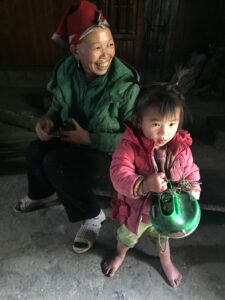
Schneider Electric’s sustainability engagement – Light it Up!
About:
Felicitas Huong Friedrich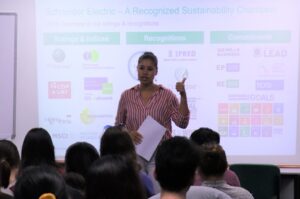 , CSR and Education Manager of Schneider Electric, Vietnam
, CSR and Education Manager of Schneider Electric, Vietnam
About Schneider Electric :
At Schneider, we believe access to energy and digital is a basic human right. We empower all to do more with less, ensuring Life Is On everywhere, for everyone, at every moment.
We provide energy and automation digital solutions for efficiency and sustainability. We combine world-leading energy technologies, real-time automation, software and services into integrated solutions for Homes, Buildings, Data Centers, Infrastructure and Industries.
With the challenges of climate change and the global megatrends made clear, the next steps also become apparent: we must act; we must take responsibility; and we must begin with ourselves. At COP21 in 2015 we unveiled our 10 sustainability commitments. The goal of these pledges is to ensure that Schneider Electric’s entire ecosystem — from our own operations to that of our suppliers, customers, and partners — becomes carbon neutral by 2025.
We are committed to unleash the infinite possibilities of an open, global, innovative community that is passionate with our Meaningful Purpose, Inclusive and Empowered values.
Schneider Electric explained in 90 secs:
[1] Felicitas clarified that Germany had a special history with Vietnam and had different policies depending whether you were from the West or East Germany. East Germany supported the “socialist brother” by supporting e.g. student exchange or having contract workers coming and working in East Germany.
West Germany mostly supported the refugees with comprehensive programs to integrate them into the German society. It impacted them differently depending what side of the German wall they started with.


6 comments
Long time supporter, and thought I’d drop a comment.
Your wordpress site is very sleek – hope you don’t mind me asking what theme you’re using?
(and don’t mind if I steal it? :P)
I just launched my site –also built in wordpress like yours– but the theme slows
(!) the site down quite a bit.
In case you have a minute, you can find it by searching for
“royal cbd” on Google (would appreciate any feedback) – it’s still in the works.
Keep up the good work– and hope you all take care of yourself during
the coronavirus scare!
There is certainly a great deal to learn about this issue.
I like all of the points you have made.
That is why I want to share with you what motivated me
to develop and earn money, maybe it will help someone: https://bit.ly/2ULpwNj
Excellent article. Keep posting such kind of info on your page.
Im really impressed by it.
Hi there, You’ve performed a great job. I’ll certainly digg it and for
my part recommend to my friends. I am sure they will be
benefited from this website.
What’s Taking place i’m new to this, I stumbled upon this I’ve found It absolutely helpful
and it has aided me out loads. I hope to contribute & help
different customers like its aided me. Great job.
https://waterfallmagazine.com
Hey there! This post could not be written any better!
Reading this post reminds me of my good old room mate! He always kept chatting about this.
I will forward this write-up to him. Fairly certain he will have a good read.
Many thanks for sharing!
Have you seen any good films recently? v tight gel walmart Scientists discovered the strain by accident while testing chickens, ducks, geese and other birds for the H7N9 virus that has infected more than 130 people and killed 40 since it was first detected in March.